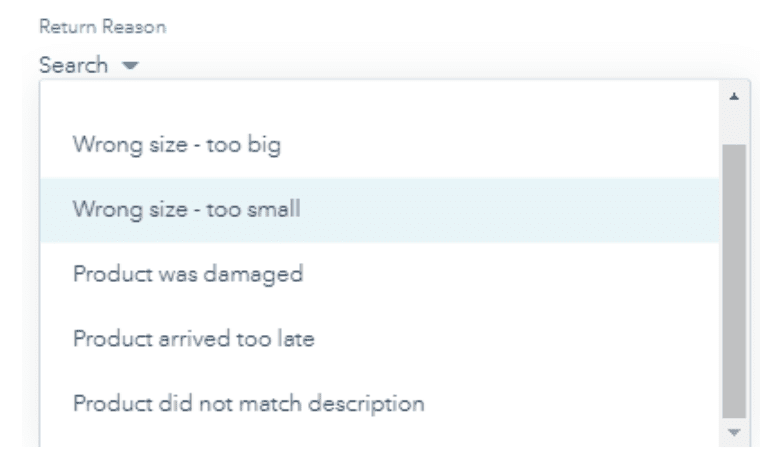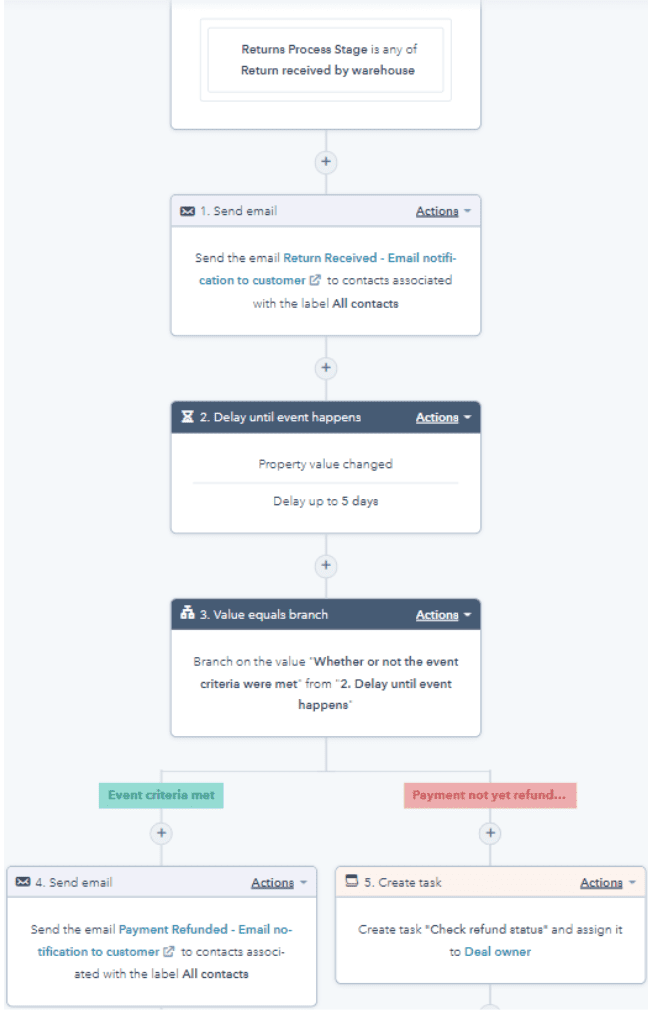Your email pings and you have a notification of an unhappy customer review: they’re not happy with your returns process. They’ll never shop with you again and recommend no-one else does either.
Sound familiar?
A poorly managed return policy can affect profitability, due to lower customer loyalty and satisfaction. Conversely, an effective and efficient returns policy can improve customer lifetime value and retain revenue.
By adding Returns as a separate entity (better known as a “custom object”) within your Hubspot account – alongside your contacts, deals and support tickets – you can start to leverage your returns process as a way to improve your profitability.
Here’s 5 ways that using a Hubspot custom object to manage your returns can save you both time and money
1. Increase customer satisfaction and repeat purchases
One of the most common problems with inefficient returns processes is that they produce unhappy customers. In fact, 95% of customers say a poor returns experience makes them less likely to shop from a brand again (2021 State of the Industry Report, Incisiv)
Look at this from the customer’s perspective: they’ve trusted your company enough to buy from you but they don’t like the product they’ve received. Their decision to return an item is unlikely to be swayed by how easy the process is, but their decision to purchase again from you definitely will be.
Pulling your returns into Hubspot adds valuable data to your team’s view of your customers. It’s just one click to get from the contact record to information about ongoing returns, recent purchases and support tickets that a customer has open with you.
A single view of every interaction that a customer has with your company – along with a quick way to filter this to the information required at any given moment – provides customer service reps with the tools they need to respond quickly and effectively to returns queries.
If a customer is having difficulty with the returns process, Hubspot empowers reps to immediately respond via any communication channel with accurate information. In turn, this leads to happier customers who are more likely to purchase from you again.
2. Improve visibility and take action to reduce the volume of returns
As your ecommerce site grows, you’ll naturally get more returns – our ecommerce clients tend to experience a 10-15% ecommerce return rate, depending on the type of product they sell.
This number can easily spiral out of control from a small, manageable amount to one which you have very little control over or knowledge of. It’s impossible to find areas where you can reduce the volume of returns coming in without knowing how many returns you are getting and when.This is made even more difficult by the fact that you’ll likely get a higher number of returns over periods when your customer service team is already really busy, like Christmas.
A Hubspot custom object enables you to track all your returns in one place in your CRM, and you can monitor that number over time. From there, you’ll be able to more accurately calculate your ecommerce return rate and look at areas of opportunity to reduce this.
Your Customer Service team can also use information they get about returns to reduce the likelihood of future returns. We monitor return reasons for clothing with one of our clients in Hubspot – such as if a brand has small sizes, or a boot is a wider fit – and update sizing information on product web pages in order to inform future customers and make returns less likely.

For management teams, visibility of returns therefore enables you to make data-driven decisions to improve your processes and website information in order to reduce the number of returns you are getting.
3. Influence wider business decisions to increase profitability
It can be frustrating to see the number of returns increasing but having no idea why – it’s a cost drain for the company and there’s no way of seeing how to improve it.
The impact of a reduction in your ecommerce return rate goes well beyond the transaction cancellation itself, as consideration must be made towards the marketing spend and employee time it took to acquire that customer in the first place. With returns data associated to contact records in Hubspot, you can start to spot trends of serial returners (aka unprofitable customers) and then exclude them from your paid advertising campaigns.
With returns information in Hubspot, you can set up reports to track the number of returns, refund amount as a proportion of overall revenue and why they’re getting returned. Associating these returns with existing deals means you can dig deeper and get insights into the types of products which are being returned more frequently.
You can only start to improve and become more efficient once you have visibility of what’s being returned and why. Having everything in one view on Hubspot gives you this visibility. It might even give you ideas on what stock to have in, or even products which behind the scenes are becoming increasingly unprofitable because they’re getting returned all the time.
Information about why products are being returned can also be vital to help customer service reps make the best recommendations for an exchange, removing the requirement of a refund. It also allows your management team to spend time training staff on your most profitable products and how to cross-sell in a way that benefits customers first and foremost.
4. Create a frictionless returns process with automations
The importance of visibility goes both ways. You might not be able to process a return and issue a refund in a day – that’s normal. But you can keep your customers updated with the process as they go through it.
Automations in Hubspot enable teams to increase the efficiency of their returns process, while increasing customer satisfaction at the same time. Once a return is received, you can use an automated workflow to send an email to notify the customer. When the payment has been refunded, automate another email to let the customer know.
These types of interactions don’t take up any extra time for your team and can help to reduce the returns burden. They also help to increase your engagement with customers, even while they are aiming to get a refund from you. A hassle-free returns process, where customers are kept up to date with progress, will help to increase trust and make them more likely to return again to shop with you. In other words, they’ll be less likely to go online and write that bad review.

5. Gain insights to speed up the returns process
Let’s say your returns process takes 2 weeks in its entirety. It has always been that way and there are no obvious methods to reduce it. But do you know what part of the process is taking the most time?
Adding your returns information to Hubspot via a custom object means that you can track the process from start to finish and spot where bottlenecks are occurring. For example, if a customer logs their return on Day 1, you might only get a notification on Day 10 that it has reached your warehouse. This might be an anomaly, but with Hubspot reporting you can get insights on whether this is a pattern – which then potentially identifies an issue with the courier you are using.
You can also drill down into how returns are being handled across teams and individual employees, which can help to identify star performers who can help to upskill other team members. Conversely, this data also helps you to spot underperformers who might require some additional training.
Removing bottlenecks in the returns process and ensuring your team is equipped with the right training to manage returns efficiently will further help to improve a cycle of unprofitable returns.
Interested in learning more about using Hubspot to make your returns process more profitable? We’d love to hear from you – book a meeting now!
